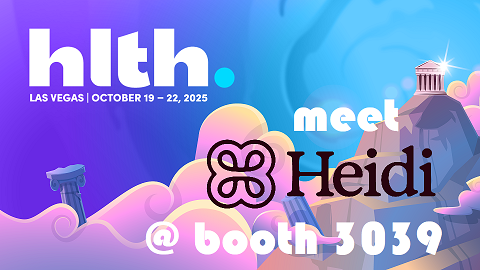 By Dr. Thomas Kelly, CEO and Co-founder, Heidi
By Dr. Thomas Kelly, CEO and Co-founder, Heidi
LinkedIn: Dr. Thomas Kelly
LinkedIn: Heidi Health
For decades, healthcare technology procurement has followed a predictable playbook: identify a regulatory need, evaluate integration capabilities, negotiate with vendors, and roll out system-wide. But ambient AI is changing this fundamental approach, forcing health systems to rethink how they evaluate and purchase healthcare technology.
The Old Way: Integration-First Thinking
Traditionally, healthcare technology decisions were driven by one primary question: “Does it integrate with our EHR?” This integration-first mindset made sense when digital tools were simply digitizing existing paper processes. EMRs needed to talk to billing systems, lab results needed to flow into patient records, and everything had to meet compliance requirements.
But here’s the problem: while patient records have become more accessible and secure, 57% of providers now report that using EHRs is a cause of burnout and has damaged the provider-patient relationship. The focus on integration overshadowed the impact on those actually using the technology.
The Ambient AI Difference: Experience-First Evaluation
Ambient AI represents a fundamental shift because it doesn’t just digitize work—it replaces it entirely. When doctors aren’t exchanging a pen for a keyboard but getting an AI assistant, the evaluation criteria must change accordingly.
Think about it this way: you wouldn’t hire a human assistant based solely on whether they can use your company’s software. You’d evaluate their ability to understand your communication style, adapt to different environments, and actually make your work easier. The same logic applies to AI scribes.
What Health Systems Should Evaluate Instead
When assessing ambient AI solutions, the focus should shift to adoption and utilization metrics rather than technical specifications. Here’s what matters most:
Physician Preference: Did your own providers recommend a tool they preferred already? Are they paying for it out of pocket? That’s a good indicator that they will continue to use it. Ambient AI should be chosen by the providers because it will be their care partner.
High Adoption: Are providers at other organizations adopting the tool at 60-80%? That’s the adoption needed to drive real transformation. Adoption should be based on real metrics–how many patient encounters are they documenting, how many other documents like referral letters are they producing–not just how many physicians signed on.
Customization Capabilities: Can the AI adapt to individual provider styles and preferences? Replacing note taking is complicated. It’s about more than what is said in the visit. Providers won’t adopt a solution that doesn’t reflect their personal preferences and thought processes.
Environmental Flexibility: Does the scribe work equally well in every clinical setting—from exam rooms to emergency departments to telehealth visits on any device? A good AI assistant should move with providers across all environments and work the same way in each.
The ROI of Getting It Right
When health systems achieve 60-80% adoption rates (as opposed to 20-40%) with ambient AI, the results are transformative. Providers can save 5-10 minutes per visit, cutting documentation time by two hours daily and potentially adding two to four more patients to their schedule. For a 1,000-provider health system, this translates to over 300,000 hours saved annually—equivalent to 175 full-time employees or nearly one million patient visits.
A New Procurement Philosophy
The shift to ambient AI requires health systems to embrace a physician-led approach to technology evaluation. Instead of making decisions in boardrooms about integration capabilities, involve the actual users in the selection process. Let doctors trial different solutions and tell you which one they prefer.
Integration remains important, but it should be viewed as a feature that enhances an already excellent product, not the primary deciding factor. When you find the AI scribe with the highest adoption rates and best user experience, integration will only amplify those benefits.
Healthcare technology procurement is evolving from integration-first to experience-first. Organizations that embrace this shift will not only see better ROI from their technology investments but will also attract and retain the physicians they desperately need in today’s challenging healthcare landscape.
For more on how to ensure you purchase the right ambient AI solution for your organization, download, Ambient AI Adoption: An Unconventional Approach that Delivers Results.
Dr. Tom Kelly on The Virtual Shift
Host Tom Foley invites Dr. Tom Kelly, Co-founder and CEO of Heidi Health, a company with an AI-powered medical scribe that streamlines time-intensive administrative tasks to reduce the cognitive load on clinicians. Tom shares insights on how Ambient AI can alleviate clinicians spending so much time on admin and notes making them less available for patient care and creating more capacity while bringing back the joy of medicine.

